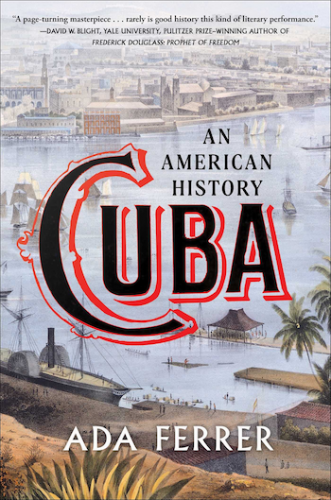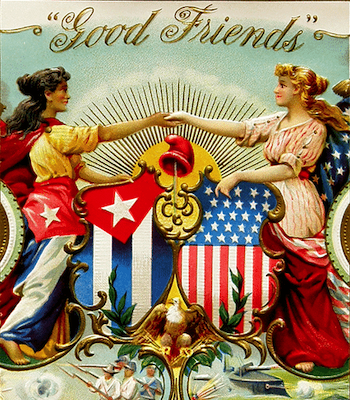Book Review: “Cuba: An American History” — Inextricably Linked, for Better and Worse
By Jeremy Ray Jewell
As we hopefully continue to reevaluate our relationship with Cuba, this masterful history should prove an invaluable asset for us all.
Cuba: An American History by Ada Ferrer. Scribner, 576 pages, $32.
 We’ve had many reasons to reexamine our relationship with Cuba in recent years. Those from different backgrounds will approach the island with varying associations. As a Floridian, I grew up with the full gamut of the state’s connections with the country: Ybor City, Little Havana, Ernest Hemingway, Elián González, and Marco Rubio. My parents practiced hiding under desks and waved to the convoys on their way to Key West during the Cuban Missile Crisis. As we learned about Florida’s history in school, Havana seemed to be behind it all — to the point that there was an almost mythical resonance.
We’ve had many reasons to reexamine our relationship with Cuba in recent years. Those from different backgrounds will approach the island with varying associations. As a Floridian, I grew up with the full gamut of the state’s connections with the country: Ybor City, Little Havana, Ernest Hemingway, Elián González, and Marco Rubio. My parents practiced hiding under desks and waved to the convoys on their way to Key West during the Cuban Missile Crisis. As we learned about Florida’s history in school, Havana seemed to be behind it all — to the point that there was an almost mythical resonance.
Evidently, so the myth goes, Spanish Floridian civilization just packed its bags and moved to Cuba in 1821, along with many of the first Indigenous and Black contributors to the peninsula’s history. For hundreds of years, the Spanish (and by extension Cuban) presence in Florida took the form of some long-lost, usually fuzzy fable. As the crackers in Marjorie Kinnan Rawlings’s novel The Yearling concluded, “The Spaniards come from acrost the ocean, and went tradin’ and fightin’ and marchin’ acrost Floridy, and no man knows where they’re gone.” I suppose that idea still pretty much shapes the popular understanding of Cuba-US relations, in Florida and otherwise. Some names and dates stick out here and there, but the person on the street will most likely date our two nations’ relationship to the Cuban Revolution and the embargo that followed.
Given this state of ignorance, Ada Ferrer’s smoothly written Cuba: An American History stands as a necessary corrective. Handed this well-researched narrative, readers will see that the relationship between Cuba and the US has always been intimate — essential, even. From its birth, Cuba has reflected, in miniature, what has been going on to its north — sometimes moving toward acceptance, at other times toward rejection. On the other hand, and to a surprising degree, the US has always kept a close eye on events on the island, either fearing that they would spill over across the Straits of Florida or hoping that they would facilitate closer cooperation between the two countries. Meanwhile, the cry we hear today remains largely the same as what we have always heard: that America wants nothing more than freedom and democracy in Cuba. That is the story today, and throughout history the line has been the same, including the numerous occasions that the US (or, before that, Britain) intervened in the island. Yet, as Ferrer makes clear with admirable determination, that desire was only partially true. The real driver behind our interests in the island has always been access to its resources and labor — the latter being enslaved for most of Cuba’s history
From the outset of their colonial enterprises in the New World, the British were often keen to differentiate their Protestant rule from “despotic” Catholic rule. During the Seven Years’ War, this justified the Siege of Havana, which gave many American colonists their first whiff of Cuban wealth. Havana, larger than any British settlement, contained riches and commanded resources that its Anglophone neighbors could, at the time, only dream of. Afraid that the British would offer freedom to Cuban slaves in exchange for their support during the siege, Cuba’s governer preemptively offered them the same. Along with the promises of freedom, Cuba’s population of enslaved and free people of color were no doubt guided by the well-founded conclusion that British rule would mean an increase in the slave trade. With reinforcements from New York and New England, the British finally captured the city. In “less than a year, the British expanded the size of Havana’s enslaved population by about 80 percent,” writes Ferrer, while also securing the future importance of sugar in the island’s economy. Sermons in Boston hardily celebrated the British success, seeing the triumph of mercantilism as a victory for God and Protestant liberty. A pattern was set.

Cuban travel brochure in the 1950s.
Another pattern established at the time was the mutual recognition of Cubans and North Americans that their economic self-interests transcended (to an extent) the politics of their respective empires. It was all about preserving the business of slavery. Spain supported the American Revolution and Cubans raised funds for the colonies while also fighting the British themselves. The turn of the 19th century went further in strengthening the goal of slavery’s preservation, though this was rocked by the Haitian Revolution, the British ban on the slave trade, and the 1811 Spanish abolition of colonial slavery. Not just independence from Spain, but annexation by the United States became the surest way for Cuban planters to preserve their slave economy. Keep in mind, “Cuban planters” were becoming an increasingly diverse bunch with the arrival of the 19th century: they included many New Englanders and others from the north. In this way, Cuba became embroiled profoundly in the push for expansion that preceded the Civil War. Pro-slavery forces (mainly) vied for Cuban annexation with the same enthusiasm that drove interest for Texas and other Mexican territories. For example, when a veteran of the Mexican-American War, New Hampshire’s Franklin Pierce, was elected on a pro-expansion platform, his vice president, Alabama slaveholder William R. King, was inaugurated on a plantation in Cuba.
So it is easy to see how understanding the evolution of Cuba-US relations provides us with an invaluable key for comprehending our own history. As Ferrer writes,
In recent years, it has become commonplace to point out that slavery — as the beating heart of an economic system that linked the US North and South — built capitalism. But neither slavery nor capitalism was ever circumscribed by national boundaries. Slave-grown cotton from the US South fed the textile mills and factories of the Industrial Revolution in England and the US North. Slave-grown sugar from Cuba helped kill the hunger of their workers, and its profits fueled the growth of American industries. Cuba — its sugar, its slavery, its slave trade — is part of the history of American capitalism.
It was in the name of American capitalism, with its backbone of slavery, that the US tried to either purchase or annex Cuba throughout the years. It was in its name, also, that Cuban filibuster Narciso López (whose financial supporters included John C. Calhoun, Robert E. Lee, and Jefferson Davis) joined the ranks of pro-slavery private citizens engaged in efforts of territorial expansion, such as William Walker. And when López mounted his second filibustering attempt to annex Cuba, the Manhattan headquarters of the New York Sun first flew the “new” Cuban flag, in support of both preserving slavery for US capital and freeing Cuba from Spanish despotism.

Historian Ada Ferrer. Photo: Teresita Fernández
Ferrer also probes how this history of profiting and opportunism inevitably generated some promising side effects. A free Black man from South Carolina named Juan Barbier, assuming the identity of a Black Haitian general, traveled to Havana in 1812 to stoke revolution. In the same year, free Black Cuban José Antonio Aponte would be detained by authorities for plotting a slave revolt: a portrait of George Washington was found among his possessions. In such instances, we catch a glimpse of how our better angels, with their hymns of freedom, have inspired hopes and dreams of a better world. From Havana’s Capitol, modeled after DC’s, to baseball and immigration, the intermingling of Cuba-US relations has created some splendid achievements. Still, Ferrer takes pains for us to know that such accomplishments are meaningless if we do not understand the larger framework within which they took place — how they happened despite systemic obstacles.
As we continue to reevaluate our relationship with Cuba, this work will no doubt prove to be an invaluable resource. Ferrer argues that the freeze in the relationship between the two countries is less about distance than it is about intense proximity. What separates us is not so much ideological conflict as it is concrete and historical conflicts. History demonstrates that Americans — when they visit Cuba as they once did — can expect to find a sibling nation, a culture with profound bonds to our own. At the same time, the past suggests what any Cuban may expect to find if visiting America once again: a government that is more often than not internally conflicted about its overtures toward its neighbor. This is a wariness that is also reflected in those who govern Cuba. Underneath this tension, Ferrer saliently argues, endures an abiding similarity between the two countries. Perhaps the old maxim, repeated by both pro-slavery and pro-freedom folks on both sides of the Straits of Florida, is true: there is simply no keeping us apart. It is, as John Quincy Adams observed, a simple law of political gravitation.
Jeremy Ray Jewell hails from Jacksonville, FL. He has an MA in history of ideas from Birkbeck College, University of London, and a BA in philosophy from the University of Massachusetts Boston. His website is www.jeremyrayjewell.com.
